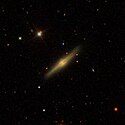IC 4225
| Galaxie IC 4225 | |
|---|---|
 | |
| SDSS-Aufnahme | |
| AladinLite | |
| Sternbild | Jagdhunde |
| Position Äquinoktium: J2000.0, Epoche: J2000.0 | |
| Rektaszension | 13h 20m 00,9s[1] |
| Deklination | +31° 58′ 53″[1] |
| Erscheinungsbild | |
| Morphologischer Typ | S0/a / PAS[1] |
| Helligkeit (visuell) | 14,3 mag[2] |
| Helligkeit (B-Band) | 15,2 mag[2] |
| Winkelausdehnung | 1,00' × 0,3'[2] |
| Positionswinkel | 133°[2] |
| Flächenhelligkeit | 12,9 mag/arcmin²[2] |
| Physikalische Daten | |
| Rotverschiebung | 0.018139 ± 0.000083[1] |
| Radialgeschwindigkeit | 5438 ± 25 km/s[1] |
| Hubbledistanz vrad / H0 | (245 ± 17) · 106 Lj (75,0 ± 5,3) Mpc [1] |
| Geschichte | |
| Entdeckung | Stéphane Javelle |
| Entdeckungsdatum | 6. Juni 1896 |
| Katalogbezeichnungen | |
| IC 4225 • UGC 8378 • PGC 46507 • CGCG 160-198 • 161-016 • MCG +05-31-177 • 2MASX J13200088+3158527 • GALEXASC J132000.88+315853.9 • LDCE 956 NED003 | |
IC 4225 ist eine linsenförmige Galaxie vom Hubble-Typ S0/a[2] im Sternbild Jagdhunde am Nordsternhimmel. Sie ist schätzungsweise 245 Millionen Lichtjahre von der Milchstraße entfernt und hat einen Durchmesser von etwa 70.000 Lj.
Im selben Himmelsareal befinden sich u. a. die Galaxien NGC 5074, NGC 5127, IC 4226, IC 4227.
Das Objekt wurde am 6. Juni 1896 vom französischen Astronomen Stéphane Javelle entdeckt.[3]
Weblinks
Einzelnachweise
Auf dieser Seite verwendete Medien
Autor/Urheber: Sloan Digital Sky Survey, Lizenz: CC BY 4.0
The sky image is obtained by Sloan Digital Sky Survey, DR14 with SciServer.
Angle of view: 4' × 4' (0.3" per pixel), north is up.
Details on the image processing pipeline: https://www.sdss.org/dr14/imaging/jpg-images-on-skyserver/



